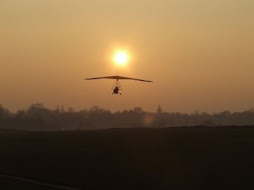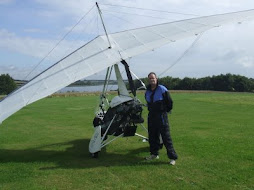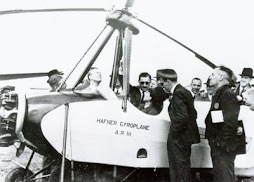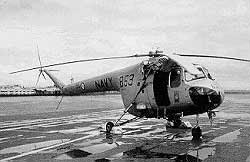skip to main |
skip to sidebar
 Sheltering in the hangar, working on my trike, between trips across the airfield in driving rain to my van to get tools etc, and feeling sick into the bargain, none of the jobs really seemed to go very well last Sunday. All my efforts seemed frustrated ....bolts that wouldn't come un-done, my 10mm spanner being missing, phillips heads in danger of rounding off, etc.
Sheltering in the hangar, working on my trike, between trips across the airfield in driving rain to my van to get tools etc, and feeling sick into the bargain, none of the jobs really seemed to go very well last Sunday. All my efforts seemed frustrated ....bolts that wouldn't come un-done, my 10mm spanner being missing, phillips heads in danger of rounding off, etc.
But finally, I got the carburetter off (being careful to photo everything as I did it because this is NOT an easy set-up); packed my bogey wheel bracket with plastic angle pieces (as advised by Ben) to stop wearing the keel; and wired in the gps auxiliary power supply, which didn't draw power when it was done, so presumably the engine has to be running (which I didn't try because I didn't have my prop on, but it makes sense, on reflection).
A tricky part of the re-fitting is going to be threading frayed steel throttle cable through the small hole in that brass cylinder at the top of the groove (see picture).
Suggestions anyone?






 Click on images to see them more clearly
Click on images to see them more clearly
Opinions differ about whether you should EVER stick anything in a carb jet, but on Bruce's advice I used a fine strand of brass taken from a cheap BBQ brush, bought for the purpose at a hardware shop. (I pulled the strands out with pliers and now have a supply in a 35mm film pot). The thing about brass is that it is a soft metal, so ought not to scratch the surface of the jets, while still being useful to remove any stubborn deposits or flecks. The brush strands are zig-zaggy, which makes them a tiny bit more abrasive. I did this with great care.
When everything seemed clean (time will tell), I dried everything completely with compressed air, which I also powered through the jets to make sure there was nothing at all left in them, then reassembled the carburetter.
There may be a slight delay in the GO SOMEWHERE plan, as Paul Bailey has expressed the view that my rev hunting was due to varnish in my carb, and also Bailey's (confirmed by Ben) say that Flylight now set up revs at 2,500 rather than 3,000- to aid landing on the Dragonfly, as its wing resists coming down at the best of times; so I am reluctant to leave mine at over 3,000.
So, I need to clean my carb, which ought then to make it easier to adjust the tick-over.
A slower idle ought to improve my consumption too, so it is a good way to go.
.
I was the last one down last night and the first up this morning...and as nobody was about, either time, I did a fair bit of larking about. Completely brilliant to be flying again.
Then I fitted the tacho and saw how dramatically my revs fluctuated close to idle. I fiddled around with settings much of the day and couldn't for the life of me get it sorted. Dave Broom offered to have a look at it at the end of the day, so I hung around, chatting to loads of people. And after all that, it took him less than 5 mins to get it set up. He has got it stabilised a couple of hundred revs above the 3,000 specified.
So, next time I go to Sutton Meadows, I am going to GO SOMEWHERE...no more anxious hanging about near the airfield.
(This week I need to solder some spade contacts on to my GPS power supply connector. Fitting that to the auxiliary power supply is the next job for when I go up to SM)
I flew this evening! I'd spent the afternoon doing a mod on my throttle, which increased its pivot from an M3 to an M5, increasing the surface area of washers etc, so that it won't slip (thank Steve for sending me the drawings). It should have been a simple mod but my pivot bolt had become very slightly distorted and would neither tighten nor undo, so I had to drill it out and file the button head off...with a crappy drill bit (and nothing adequate to pilot the hole as I hadn't anticipated the problem). Anyway, eventually the job was done and I was just packing away when Dave Broom and John Lawrance, who had both just landed, urged me to get some in before sunset. I had to get a move on....but it was worth it!It was completely glorious!I am now in the clubhouse at Sutton Meadows and have discovered this computer (wireless generously provided by Dave Broom), so no longer feel quite as cut off; it is deadly quiet here. I forgot to bring my radio. I remembered school stuff, with a view to planning lessons, but am I, 'eck ;)The plan is to sleep here the night, rise at about 5.30 and rig to fly before sunrise. The winds, which I haven't checked yet, were due to be around 7mph at 7a.m. and rising, so I need to get airborn and back down again and de-rigged before ten to avoid the worst of it.Crikey, it feels good to be back!(tomorrow's jobs incl fitting the tacho and checking my power settings)
Paul Bailey said that Paramotorists always drain their carbs when they pack up, but I'd naively imagined that was because they were planning to put their equipment flat in their cars and didn't want it dripping on their seats.
One thing I don't get is, if you have to refuel each time, why don't Bailey's provide primers on the fuel system? One of my correspondents is an electrical engineer and he is very unhappy with the fact that I have to keep a finger on the starter for longer at start-up to pump fuel to the carb. Apart from being a heavy load on the battery, it must put a heat strain on the wiring loom.
The manual says you shouldn't have your finger on the button for longer than 5 seconds but past experience showed that 5 seconds wasn't long enough to lift the fuel. Ben advised me to turn over for up to a minute. He said, "pissing in the wind is better than 5-second bursts". I drained a battery doing those...with Steve timing me, religiously.
I thought I had solved this problem, now that I am hangering, by leaving fuel in the system...but this week's drama has taught me a lesson: I need to drain the system (keeping the fuel in an unvented container) and refuel each time, and . . ..
I need a primer.
They don't appear to be easy to get from aviation suppliers, but would probably be ludicrously expensive if they were, but I have found them on marine supply sites for about £5.
An image search on Google suggests that I'd just cut my fuel line above the filter and insert the bulb between the filter and the pump/carburetter.
Thoughts, anyone?

The other news is that we are to be joined in the Dragonflying fraternity by Wayne Lofts, with whom I have enjoyed a summer of phonecalls and texts. He is to have a red trike and a red and grey wing. Formerly Wayne had a Quik but has been inspired by Will Minns, Steve Wilson and myself to experience not merely piloting but actually pretty damn close to pure flight...and to do so at a considerable reduction in expense.Welcome Wayne!.
On the very last day of a summer holiday spent grounded by winds, I finally got airborne. This day's other great significance was that it was the first take-off since I ploughed into a field of crop when my big end bearing failed on the climb-out in June.
And this time, as I took off I was clearly under-powered and naturally this alarmed me more than it might otherwise have done and, aware that I had to immediately set myself up for an emergency landing, (and not get caught out by continuing into wind as I did last time - running out of runway), I called Mayday and did a tight turn downwind and then, still high, lined up at the start of the runway (and this is the funny thing with the Dragonfly wing) couldn't dump sufficient height to get in on the first run, so had to go around, but again in a very tight circuit. Once down, the engine died at idle. I restarted and Dave Garrison (who had given way to me in the circuit) reminded me to cancel the Mayday, after which, I taxied in to work out what was wrong.
A quick call to Paul Bailey suggested the main reason:- I had flown on a tank full of fuel that had been venting since the 6th July. No wonder it had lost its potency at the top end! Also, he said, having left the fuel in the carb the jets would be (what word did he use?) coated in the residue of the old fuel and this would affect the settings. He said that running new fuel through the carb would clean the jets. Never leave fuel in a carb for more than two weeks.
Lesson learned.
Steve has mentioned this before and I had forgotten. Others say they top up with fresh fuel, but this time I drained mine off completely and filled with new stuff and that did the trick.
I flew another circuit, but again came down very quickly because my throttle was slipping, so that I couldn't fly without keeping one hand on it. Once down, I tightened it.
Dave Broom kindly took G-CFKK up and confirmed that it was now climbing well but said he too had trouble with a slipping throttle. I tightened the throttle as best I could without the right allen key, and then went to test it again but aborted when the runway vibration made the throttle slacken again.

 Today I have bought some nuts and super glue for the throttle job and next time, and from now on, will be monitoring engine revs with a Tiny Tach *, a very nice little tachometer which works by induction (by wrapping a lead around the HT lead) to measure the number of sparks per second - and giving an RPM read-out. That should take the guess work out of power settings. Then all I need is a good flight to overcome the psychological block at take-off....the anxiety, which I didn't know was there, that I won't have enough power to get airborne.
Today I have bought some nuts and super glue for the throttle job and next time, and from now on, will be monitoring engine revs with a Tiny Tach *, a very nice little tachometer which works by induction (by wrapping a lead around the HT lead) to measure the number of sparks per second - and giving an RPM read-out. That should take the guess work out of power settings. Then all I need is a good flight to overcome the psychological block at take-off....the anxiety, which I didn't know was there, that I won't have enough power to get airborne.
*The Tiny Tach cost me £45, which includes VAT and postage. You pay by return, once the item has arrived. I thought that very reasonable. The one done by Bailey was more expensive and anyway has been discontinued by their distributor because the price has been hiked by the manufacturer by 30%!
 Steve, who appears to know me rather well,
Steve, who appears to know me rather well,
just sent me what he knows is my dream property.
He over-flew it yesterday evening..
 Sheltering in the hangar, working on my trike, between trips across the airfield in driving rain to my van to get tools etc, and feeling sick into the bargain, none of the jobs really seemed to go very well last Sunday. All my efforts seemed frustrated ....bolts that wouldn't come un-done, my 10mm spanner being missing, phillips heads in danger of rounding off, etc.
Sheltering in the hangar, working on my trike, between trips across the airfield in driving rain to my van to get tools etc, and feeling sick into the bargain, none of the jobs really seemed to go very well last Sunday. All my efforts seemed frustrated ....bolts that wouldn't come un-done, my 10mm spanner being missing, phillips heads in danger of rounding off, etc.











































